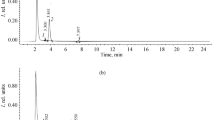Abstract
Gliotoxin, a mycotoxin with antimicrobial and immunosuppressive capabilities, is produced by several genera of fungi including the pathogenic fungusAspergillus fumigatus. The ability of selected isolates ofA. fumigatus to produce gliotoxin on three different media was tested and a thin layer chromatographic and high performance liquid chromatographic method for quantitation of gliotoxin from rice culture was developed and is described. Rice cultures were extracted with chloroform and the resulting extract was partially purified by precipitation with petroleum ether and cleanup by gel permeation chromatography. Gliotoxin was detected by thin layer chromatography and quantitated by high performance liquid chromatography using a U.V. absorbance detector with a 254 nm filter and a mobile phase of methanol-water 43∶57 (V/V) with a flow rate of 2.0 ml/min. The retention time for gliotoxin was approximately 4.8 min. From rice samples spiked with gliotoxin concentrations of 0.67, 1.33, 2.67, 4.00 and 5.33μg/g the average recovery was 83.8%.
Similar content being viewed by others
References
Boutibonnes P, Auffray Y, Malherbe C, Kogbo W, Marais C. Proprietes antibacteriennes et genotoxiques de 33 mycotoxines. Mycopathologia 1984; 87: 43–49.
Braithwaite AW, Eichner RD, Waring P, Mullbacher A. The immunomodulating agent gliotoxin causes genomicDNA fragmentation. Molecular Immunology 1987; 24:47–55.
Brewer D, Hannah DE, Taylor A. The biological properties of 3,6-epidithiadiketopiperazines. Inhibitionof growth ofBacillus subtilis by gliotoxins, sporidesmins, and chetomin. Can J Microbiol 1966; 12: 1187–95.
Cole RJ, Cox RH. Handbook of toxic fungal metabolites, New York: Academic Press, 1981:585.
Davis ND, Diener UL, Eldridge DW. Production of aflatoxins B1 and G1 byAspergillus flaws in a semisynthetic medium. Appl Microbiol 1966; 14: 378–80.
Eichner RD, Mullbacher A. Hypothesis: Fungal toxins are involved in aspergillosis and AIDS. Aust J Exp Biol Med Sci 1984; 62: 479–84.
Halder C, Taber R, Camp BJ. An analytical method for the analysis of a mycotoxin, sporidesmin, fromPithomyces chartarum. The Texas Agricultural Experiment Station: 60–61.
Hussain SA, Qureshi IH. Part I. Isolation and characterization of gliotoxin, ergosterol, palmitic acid and mannitol — metabolic products ofTrichoderma hamatum Bainier. Pakistan J Sci Ind Res 1975; 18: 221–3.
Johnson JR, Bruce WF, Dutcher JD. Gliotoxin, the antibiotic principle ofGliocladium fimbriatum. I. Production, physical and biological properties. J Am Chem Soc 1943; 65: 2005–9.
Jordan TW, Cordiner SJ. Fungal epipolythiodioxopiperazine toxins have therapeutic potential and roles in disease. Trends in Pharmacological Sciences 1987; 8: 144–9.
Larin NM, Copping T, Herbst-Laier RH, Roberts B, Wenham RB. Antiviral activity of gliotoxin. Chemotherapia 1965; 10:12–23.
Lundborg M, Holma B. In vitro phagocytosis of fungal spores by rabbit lung macrophages. Sabouraudia 1972; 10:152–6.
Mason JW, Kidd JG. Effects of gliotoxin and other sulfur-containing compounds on tumor cells in vitro, with observations on mechanism of action of gliotoxin. J Immunol 1951; 66: 99–106.
Mortimer PH, Ronaldson JW. Fungal-toxin-induced photosensitization. In: Keeler RR, Tu AT, eds. Plant and fungal toxins — Handbook of natural toxins, Vol. I. New York: Marcel Dekker, Inc., 1983; 361–419.
Mullbacher A, Waring P, Eichner RD. Identification of an agent in cultures ofAspergillus fumigatus displaying anti-phagocytic and immunomodulating activity in vitro. J Gen Microbiol 1985; 131: 1251–8.
Nagarajan R. Gliotoxin and epipolythiodioxopiperazines. In: Betina V, ed. Mycotoxins-production, isolation, separation and purification. Amsterdam: Elsevier, 1984; 351–85.
Niyo KA, Richard JL, Niyo Y, Tiffany LH. Effects of T-2 mycotoxin ingestion on phagocytosis ofAspergillus fumigatus Fresenius conidia by rabbit alveolar macrophages and on hematologic, serum biochemical, and pathologic changes in rabbits. Am J Vet Res 1988; 49: 1766–73.
Richard JL, Thurston JR. Effect of aflatoxin on phagocytosis ofAspergillus fumigatus spores by rabbit alveloar macrophages. Appl Microbiol 1975; 30: 44–7.
Rippon JW. Aspergillosis. In: Rippon JW, ed. Medical mycology-The pathogenic fungi and pathogenic actinomycetes, 2nd Philadelphia: W.B. Saunders Co., 1982:565–94.
Schaffner A, Douglas H, Braude A. Selective protection against conidia by mononuclear and against mycelia by polymorphonuclear phagocytes in resistance to Aspergillus. J Clin Invest 1982; 69: 617–31.
Schaffner A, Douglas H, Braude A, Davis CE. Killing of Aspergillus spores depends on the anatomical source of the macrophage. Infect and Immunol 1983; 42: 1109–15.
Shotwell EL, Hesseltine CW, Stubblefield RD, Sorenson WG. Production of aflatoxin on rice. Appl Microbiol 1966; 14: 425–8.
Stack ME, Nesheim S, Brown NL, Pohland AE. Determination of sterigmatocystin in corn and oats by gel permeation and high-pressure liquid chromatography. J Assoc Off Anal Chem 1976; 59: 966–70.
Taylor A. The toxicology of sporidesmins and other epipolythiodioxopiperazines. In: Kadis S, Ciegler A, Ajl SJ, eds. Microbial toxins, Vol. VII. New York: Academic Press, 1971; 337–76.
Tonsager SR, Maltby DA, Schock RJ, Braselton WE. Sample purification of mycotoxins by gel permeation. Adv. Thin Layer Chromatogr., (Proc. Bienn. Symp.). 1982: 389–402.
Waring P, Eichner RD, Palni U, Mullbacher A. The isolation and identification of a new metabolite fromAspergillus fumigatus related to gliotoxin. Tet Letters 1986; 27: 735–738.
Weindling R, Emerson OH. The isolation of a toxic substance from the culture filtrate of Trichoderma. Phytopath 1936; 26: 1068–70.
Author information
Authors and Affiliations
Rights and permissions
About this article
Cite this article
Richard, J.L., Lyon, R.L., Fichtner, R.E. et al. Use of thin layer chromatography for detection and high performance liquid chromatography for quantitating gliotoxin from rice cultures ofAspergillus fumigatus Fresenius. Mycopathologia 107, 145–151 (1989). https://doi.org/10.1007/BF00707552
Accepted:
Issue Date:
DOI: https://doi.org/10.1007/BF00707552




